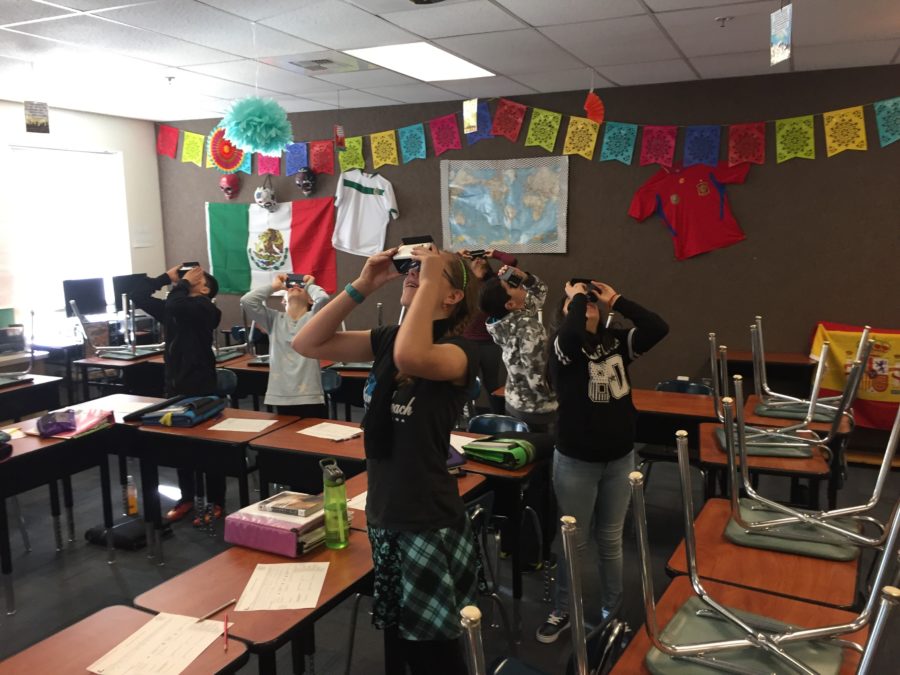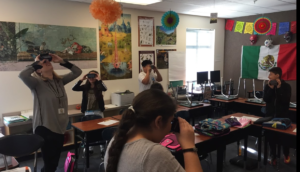
Most people are surprised to hear that I use virtual reality in my rural middle school classroom and even more amazed when they hear that I use it to enhance my students’ study of the Spanish language. “That doesn’t sound like the Spanish classes that I took in school,” they say. I use project based learning with STEAM strategies (science and arts integration) and BreakOut Boxes (escape-room style challenges)…..so why not virtual reality?
Experimentation and reflection is essential for growth no matter your professional field. For this reason, when Paul Zimmerman, the district tech integration specialist offered teachers in Blaine County Schools the opportunity to pilot the newly acquired virtual reality kit, I jumped at the opportunity. I had hoped that the experience with VR would complement a career exploration unit to excite students as they considered potential jobs and toured universities. I constantly push myself to take academic risks as an educator (even if it scares me) and attempt to model this behavior for my students. With the right type of mindset, fear of the unknown and discomfort can often produce the greatest personal growth.

Sixth grade students touring behind the scenes at Youtube and Googleplex.
As a teacher, I feel compelled to plan, plan, plan! I actively work to foresee potential issues so that I may be prepared to problem-solve in the moment and keep the activity going. I met with the tech specialist well ahead of my VR career exploration day to learn how to set up and run the kit with the viewers and phones, and anticipate connection problems to the network. I reviewed how to lead a Google Expedition several times, agonized over potential content, prepared Google Forms for kids to vote on top jobs to shadow, and planned how to balance excitement regarding the novelty of VR with the opportunity to share and record observations and changing perceptions.
When the day arrived to use the VR kits (an alternative kit to Google Cardboard that our specialist assembled), my worries quickly faded as the students squealed with delight. Students weren’t just shadowing these careers. They were actually becoming marine biologists and software engineers. They were captivated with living the experience of gathering research samples from the ocean, performing dissections, learning to operate a submersible and how to scuba dive with seals and tropical fish off the Galapagos Islands of Ecuador. Furthermore, I couldn’t believe how excited all students were to become software engineers at YouTube and Google! Even though the students had voted to view this career, I had worried that it might be boring for them. I was wrong! Students loved getting to see ‘behind the scenes’ at the companies whose technologies they use every day! Students thought that the Googleplex campus was beyond belief as a sort of adult playland instead of a workplace. The tour was so impactful that countless students became obsessed with the idea of working in the tech industry. They became thirsty to learn more about how to accomplish it with their studies (Keep in mind that these are 6th and 7th graders!!). After VR tours of public and private universities around the country, students (many of whom would be first generation college students) were proudly spouting information about degrees they wanted to get at Boise State, Stanford or Northwestern, among others, in order to obtain the jobs of their dreams!

Students playing around with the viewers. They wanted to understand how they worked!
It also occurred to me that students should take the reins to lead their parents through the virtual reality job exploration process during our parent-teacher conferences. Students were dragging their parents through the classroom doors as quickly as they could to show them more about how they wanted to be a biologist, engineer, etc. Students jumped in with ease to show parents how the VR viewers worked. These initial experiences with virtual reality were transformative for me, the students and their parents. It was empowering for all to experiment with the unknown, gain knowledge and share this with others, while yearning for more.
After reflecting on the first VR activities and gaining confidence, I felt that the next step was to set up a more dynamic and immersive experience for the rest of my courses. I used YouTube 360 videos versus the still images of Google Expeditions. Although Google Expeditions offers educators more control to pause the experience or indicate points of interest to students, the 360 video advances a more intensely memorable and individualized learning experience. Students can determine their own pace and can view content in the order of their own interests within the selection of videos on the teacher’s YouTube playlist. Another option is to have a more collective experience with everyone starting the video at the same time while the audio plays on the class-wide sound system.
The level of excitement and engagement continues to soar with all of my classes with the use of various VR 360 experiences. Literacy development and spatial awareness is enhanced as students tour sites visited by the main characters and actually participate in cultural events from our novels. For example, students tour the dream-like modernist buildings of Gaudi in Barcelona and feel the adrenaline rush of running with the bulls at the San Fermin Festival in Pamplona, Spain. In another course, students gain a sense of empathy with a boy their age from an indigenous group as they follow him through his endangered area of the Amazon in Ecuador. Additionally, students learn firsthand with the boy how to farm cacao sustainably to protect the environment and earn a more livable wage for the community with the help of a non-governmental agency. Through additional reflection, students identify surprising parallels between their lives and the life of the boy from the VR videos and our short non-fiction story.

Scuba diving in the Galapagos.
After learning about the Idaho Virtual Reality Council this summer, I am energized and encouraged to continue my exploration of the application for virtual reality in the classroom. After attending the recent membership meeting, I look forward to collaborating with others in this innovative community such as VRigami. I would love for my students to build a virtual space to solve a problem and then be able to tour their own designs for further empowerment. For example, we learn to design eco-friendly homes through the use of Planner 5D. It is my hope that students could develop their eco-house designs and then tour their own constructions within virtual reality through the VRigami app. I look forward to the opportunity to learn from such talented members of the VR community in Idaho.
Future plans for our school district include the ability for students and teachers to film their own 360 immersive videos. We would also like to conduct a community or state-wide drive to encourage the public to donate used smartphones to us in order to expand access to virtual reality for all students. At this point, we have one VR class set that must be shared among all elementary, middle and high schools in the district. I will also apply for grants this summer to purchase VR viewers.
Technology such as virtual reality, when used in a meaningful way, can enhance student thinking and inspire creativity in the demonstration of new knowledge. Technology provides rich content and tools for collaborative experiences, creative outlets for design and presentation of ideas in a more visual, memorable way. As educator and author David Warlick proclaims, “We need technology in every classroom and in every student and teacher’s hand, because it is the pen and paper of our time, and it is the lens through which we experience much of our world.” As a result, technologies such as virtual reality should be leveraged to support teaching and learning within a real world context. As a Spanish educator, I use virtual reality and other tools and applications to provide second language learners with the opportunity to go beyond the classroom into a global setting to experience other cultures and ways of thinking. I work tirelessly to continue to learn about emerging technologies so that my students have the best opportunities to prepare themselves for the 21st century workplace. In this way, we can all continue to explore the possibilities of learning through collaboration, communication, design, storytelling, gaming, and multimedia production…..all in another language!

Erika Liebel, Spanish Educator, Wood River Middle School, eliebel(at)blaineschools.org



Recent Comments